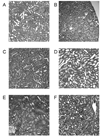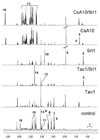Association of immunosuppressant-induced protein changes in the rat kidney with changes in urine metabolite patterns: a proteo-metabonomic study
- PMID: 19994912
- PMCID: PMC3955702
- DOI: 10.1021/pr900761m
Association of immunosuppressant-induced protein changes in the rat kidney with changes in urine metabolite patterns: a proteo-metabonomic study
Abstract
The basic mechanisms underlying calcineurin inhibitor (CI) nephrotoxicity and its enhancement by sirolimus are still largely unknown. We investigated the effects of CIs alone and in combination with sirolimus on the renal proteome and correlated these effects with urine metabolite pattern changes. Thirty-six male Wistar rats were assigned to six treatment groups (n = 4/group for proteome analysis and n = 6/group for urine (1)H NMR metabolite pattern analysis): vehicle controls, sirolimus 1 mg/kg/day, cyclosporine 10 mg/kg/day, cyclosporine 10 mg/kg/day + sirolimus 1 mg/kg/day, tacrolimus 1 mg/kg/day, tacrolimus 1 mg/kg/day + sirolimus 1 mg/kg/day. After 28 days, 24 h-urine was collected for (1)H NMR-based metabolic analysis and kidneys were harvested for 2D-gel electrophoresis and histology. Cyclosporine affected the following groups of proteins: calcium homeostasis (regucalcin, calbindin), cytoskeleton (vimentin, caldesmon), response to hypoxia and mitochondrial function (prolyl 4-hydroxylase, proteasome, NADH dehydrogenase), and cell metabolism (kidney aminoacylase, pyruvate dehydrogenase, fructose-1,6-bis phosphate). Several of the changes in protein expression, confirmed by Western blot, were associated with and explained changes in metabolite concentrations in urine. Representative examples are an increase in kidney aminoacylase expression (decrease of hippurate concentrations in urine), up regulation of pyruvate dehydrogenase and fructose-1,6-bisphosphatase, (increased glucose metabolism), and down regulation of arginine/glycine-amidino transferase (most likely due to an increase in creatinine concentrations). Protein changes explained and qualified immunosuppressant-induced metabolite pattern changes in urine.
Figures







References
-
- Wong W, Venetz JP, Tolkoff-Rubin N, Pascual M. 2005 immunosuppressive strategies in kidney transplantation: which role for the calcineurin inhibitors? Transplantation. 2005;80(3):289. - PubMed
-
- Taylor AL, Watson CJ, Bradley JA. Immunosuppressive agents in solid organ transplantation: Mechanisms of action and therapeutic efficacy. Crit Rev Oncol Hematol. 2005;56(1):23. - PubMed
-
- Ojo AO, Held PJ, Port FK, et al. Chronic renal failure after transplantation of a nonrenal organ. N Engl J Med. 2003;349(10):931. - PubMed
-
- Ponticelli C, Tarantino A. Promising new agents in the prevention of transplant rejection. Drugs R D. 1999;1(1):55. - PubMed
-
- Kahan BD The Rapamune US Study Group. Efficacy of sirolimus compared with azathioprine for reduction of acute renal allograft rejection: a randomised multicentre study. Lancet. 2000;356(9225):194. - PubMed
Publication types
MeSH terms
Substances
Grants and funding
LinkOut - more resources
Full Text Sources
Other Literature Sources
Miscellaneous

